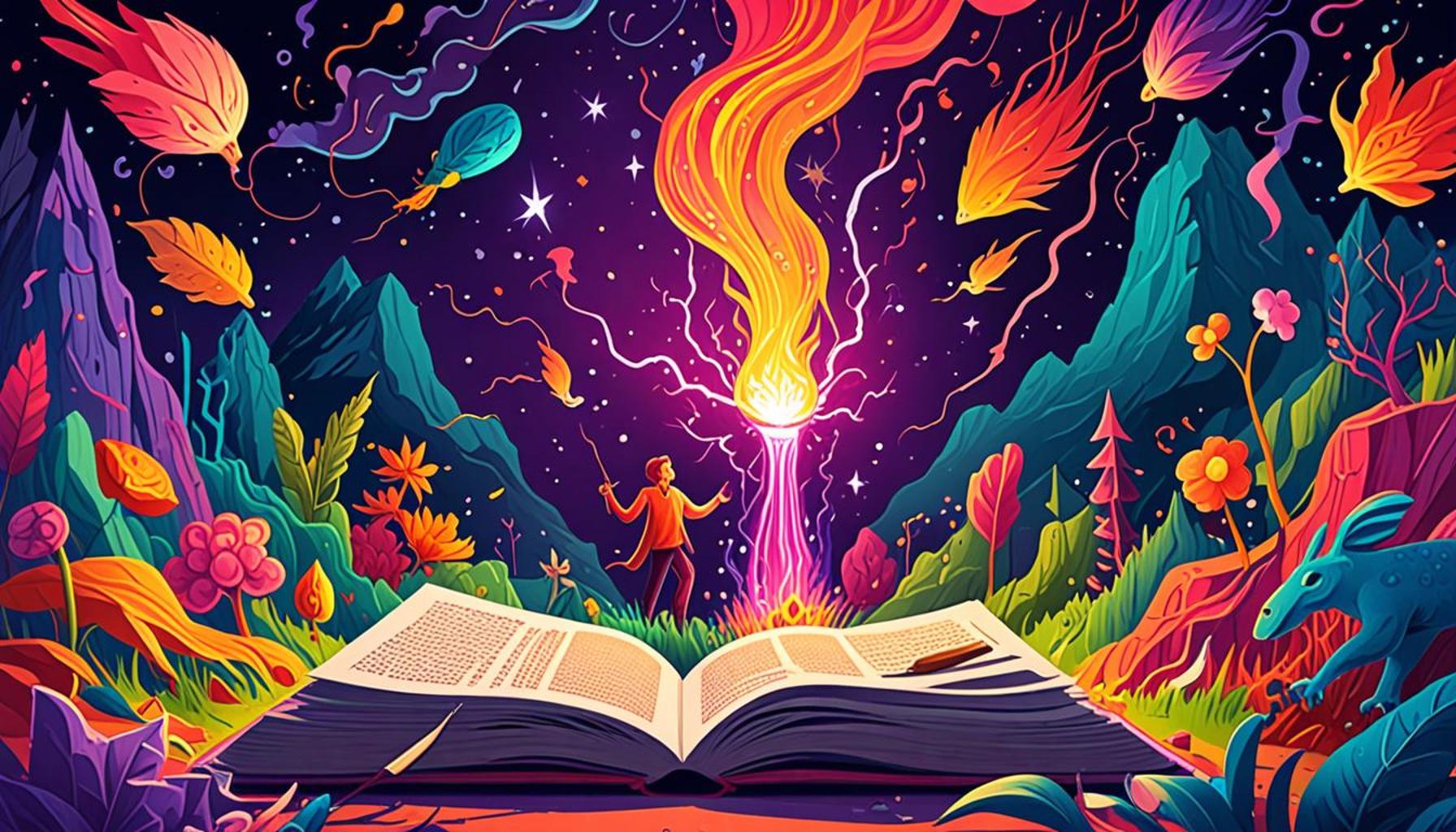The Use of Metaphor: Techniques to Enrich Your Writing with Powerful Images

Understanding the Significance of Metaphor in Writing
Metaphors are not merely embellishments; they are vital tools that breathe life into writing. By transforming ordinary language into vibrant imagery, metaphors can captivate and engage readers. In a world where words often feel stale, an effective metaphor can evoke emotions and create connections. Writers from various backgrounds utilize this technique to enhance the depth and richness of their storytelling.
Evocative Imagery
One of the most powerful aspects of metaphor is its ability to create evocative imagery. When a writer describes someone’s struggle as a “battle against a fierce storm,” it paints a vivid picture in the reader’s mind that communicates challenges and resilience. In Nigeria, where rich oral traditions thrive, a metaphor like “navigating life’s journey like a canoe through the River Niger” serves to enhance understanding and relate to the daily experiences of the people.
Emotional Resonance
Additionally, metaphors have the capacity to forge emotional resonance with readers, making the text more impactful. For instance, comparing the loss of a loved one to “a candle extinguished in a gust of wind” taps into shared feelings of grief and nostalgia. This emotional connection encourages readers to empathize and reflect on their own experiences. Nigerian storytellers often draw from communal events, such as weddings or funerals, to embed metaphors that resonate universally, accentuating the significance of shared emotions within the culture.
Clarity and Comprehension
The strength of a metaphor also lies in its ability to enhance clarity and comprehension. By simplifying complex ideas through relatable comparisons, writers can communicate effectively. For example, likening bureaucracy to “a thick jungle where decisions get lost among the trees” clarifies the frustration of navigating through red tape. This metaphor not only helps the reader visualize the situation but also connects to Nigeria’s own administrative challenges. Such imagery allows readers to grasp concepts easily without losing interest.
As we explore various techniques that refine your writing, you will discover how to effectively harness the power of metaphor. The art of crafting compelling comparisons and painting vivid scenes can transform your work significantly. Learning to utilize this literary device opens up new avenues for expression and creativity, ensuring your writing resonates with readers on multiple levels.

In conclusion, the art of metaphor is integral to storytelling. It enriches writing by creating impactful imagery, fostering emotional connections, and aiding comprehension. For Nigerian writers, the cultural significance of such devices offers a unique angle to share stories that reflect the nation’s vibrant heritage. As you embark on your writing journey, remember that mastering metaphors can elevate your narrative style and engage readers in profound ways.
LEARN MORE: This related article may interest you
Techniques for Crafting Powerful Metaphors
To truly harness the potential of metaphors in your writing, it’s essential to explore various techniques that can enhance your creativity and elevate your narrative. Below are some strategies that can help solidify your understanding and execution of this powerful literary device.
Observational Skills
One of the cornerstone techniques for developing effective metaphors is sharpening your observational skills. By closely observing the world around you—be it bustling markets in Lagos, quiet rural landscapes, or the vibrant colors of cultural festivals—you can extract vivid details that serve as the foundation for intriguing metaphors. For instance, a writer might observe how the sun sets over the Lagos Lagoon and describe it as “a golden coin dropped into a treasure chest,” which captures both the beauty and value of the moment.
Mixing Senses
Another technique is the mixing of senses, which involves combining different sensory experiences to create a rich tapestry of imagery. This can ignite the reader’s imagination and provide a more immersive experience. For example, describing a traditional Nigerian market might involve saying, “The sounds of laughter and bargaining danced through the air like the aroma of pepper soup wafting from food stalls.” This cross-sensory metaphor not only paints a clear picture but also invokes a deeper emotional response from the reader.
Drawing from Cultural References
Utilizing cultural references can add layers of meaning to your metaphors, making them more relatable to your audience. In a multicultural society like Nigeria, where diverse narratives abound, incorporating familiar cultural symbols can enhance understanding. For instance, referring to the resilience of a character as “like a lion in the savannah,” draws on the symbolism of the lion as a powerful and courageous figure in African folklore. Such metaphors resonate well with readers who share or appreciate these cultural backgrounds.
Using Comparisons and Contrasts
Effective metaphors often involve comparisons and contrasts that highlight the complexity of a subject. Writers can juxtapose seemingly unrelated ideas to unveil deeper meanings. For example, characterizing a politician’s promise as “vapor in the morning sun” offers a dual perspective: it conveys both the fleeting nature of the promise and hints at disappointment, contrasting the idealistic hopes with the harsh reality. This not only stimulates critical thinking but also invites readers to re-evaluate their perspectives.
Experimenting with Language
Finally, do not hesitate to experiment with language. The beauty of metaphors lies in their limitless possibilities. Play with variations, synthesize words, and explore unconventional phrases that challenge standard expressions. This creative experimentation can yield unexpected and striking metaphors that capture readers’ attention and curiosity.
By adopting these techniques, writers can significantly enhance their ability to create meaningful and impactful metaphors. As you practice and refine these methods, your writing will naturally evolve, allowing your metaphors to act as powerful conduits for imagery and emotion. In the next sections, we will further explore the role of metaphor in different genres and how to master the art of storytelling through visceral comparisons.
| Metaphor Techniques | Effectiveness |
|---|---|
| Symbolic Language | Enhances imagery and allows readers to visualize concepts clearly. |
| Comparison and Contrast | Creates depth in writing by comparing dissimilar things that share common traits. |
| Extended Metaphors | Develops themes throughout a piece, allowing for richer narratives. |
| Personification | Breathes life into inanimate objects, making them relatable and engaging. |
Meta-descriptions, such as “The Use of Metaphor: Techniques to Enrich Your Writing with Powerful Images,” can profoundly transform your writing experience. By employing techniques such as symbolic language and comparison, you are not only painting pictures with words but drawing readers into emotional landscapes where they can connect deeply with your subject matter. Additionally, the use of extended metaphors can pave the way for consistent thematic exploration, while personification invites readers to empathize with ideas or entities typically devoid of human characteristics. Each technique serves to enrich the reader’s journey and enhance their understanding.As you experiment with these techniques, consider how adding elevated metaphorical language can expand your audience’s engagement. By weaving nuanced and imaginative images throughout your writing, you can create a tapestry of ideas that invites exploration and sparks interest, encouraging readers to dwell longer on your insights. The power of metaphor lies in its ability to transcend the ordinary and touch the extraordinary, making it a vital tool in any writer’s arsenal.
CHECK OUT: Click here to explore more
Advanced Techniques for Metaphor Usage
After mastering foundational techniques for crafting metaphors, aspiring writers can delve into more advanced strategies that further enhance the impact of their writing. These techniques not only foster creativity but also deepen the emotional resonance of narratives. Here are some advanced approaches to consider in your metaphorical journey.
Creating Extended Metaphors
One powerful technique is the use of extended metaphors, where a single metaphor is developed in detail throughout a passage or even an entire work. This allows the metaphor to serve as a thematic thread, weaving together various aspects of the narrative. For instance, a writer might portray life as a river, exploring how it meanders through different terrains—sometimes peaceful and calm, other times tumultuous and treacherous. Such an extended metaphor not only creates cohesion within the text but also invites readers to reflect deeply on the underlying message.
Employing Visual Imagery
Another technique is to focus on generating visual imagery through metaphors. Metaphors that tap into the senses can create vivid scenes that remain etched in the reader’s mind. Consider the following description of a bustling Lagos traffic jam: “The cars were a sluggish river of metal, trapped in the concrete canyon, each honk echoing like a cry for help.” This imagery not only illustrates the chaos of urban life but also evokes empathy from readers who have experienced similar frustrations.
Pacing and Rhythm Through Metaphorical Language
The pacing and rhythm of your writing can be influenced by the metaphors you employ. Short, sharp metaphors can create urgency, while longer, flowing metaphors might evoke a sense of calm. For instance, in a suspenseful narrative, a writer might describe a character’s heartbeat as “a drum echoing a tribal call to battle,” building tension and drawing readers further into the story. By paying attention to how the rhythm of your metaphors matches the narrative’s pace, you can significantly enhance the overall reading experience.
Layering Metaphors for Depth
Incorporating layered metaphors can provide additional depth, allowing multiple interpretations and enriching the text. Imagine a metaphor describing ambition as “a flame flickering against the wind.” While this suggests both determination and struggle, one might layer another metaphor: “a seed pushed through the hard earth.” The two metaphors together encapsulate the idea of striving against adversity, illustrating the complexity of human aspiration. Layered metaphors invite readers to engage with the text on various levels, encouraging them to unravel deeper meanings.
Symbolism in Metaphors
Lastly, incorporating symbolism into your metaphors can magnify their significance. In Nigerian literature, elements like the tortoise or the masquerade may symbolize wisdom or cultural heritage, respectively. For example, describing an elder’s story as “a veil worn by the masquerade, hiding wisdom beneath flamboyant fabric” draws on cultural symbolism to enhance depth and connection with readers. Such symbolic metaphors make your writing resonate more powerfully with the audience, as they reflect shared cultural values and experiences.
By embracing these advanced techniques—extended metaphors, visual imagery, pacing, layering, and symbolism—writers can amplify the significance of their messages, creating works that are not only compelling but also resonate deeply with readers. As we continue to explore the power of metaphor, we will delve into its applications across different genres, illustrating how it can transform storytelling and connect with audiences profoundly.
RECOMMENDED: Check out this similar article
Conclusion
In conclusion, the art of crafting metaphors can significantly elevate your writing, transforming ordinary narratives into poignant and evocative experiences for readers. By embracing a variety of techniques—from extended metaphors to layered imagery—writers can create rich tapestries of meaning that not only captivate their audience but also encourage deeper emotional connections. The strategic use of visual imagery and symbolism, particularly within the cultural context of Nigeria, enables writers to resonate more profoundly with their readers, tapping into shared experiences and values that enrich the storytelling landscape.
Moreover, recognizing how pacing and rhythm in metaphorical language influences the overall tone of a piece can offer writers additional tools for enhancing the reading experience. As Nigerian literature continues to evolve, integrating these metaphorical techniques can inform not only fictional narratives but also poetry, essays, and other forms of expression, catering to a diverse audience that appreciates the nuances of language.
As you embark on your own metaphorical journey, experiment with these techniques and observe the unique ways they transform your writing. The more you practice, the more adept you will become at weaving powerful images into your work, crafting stories that linger in the minds of your readers. Take the time to explore the depths of metaphor; the artistry you cultivate will convey your message with clarity and vibrancy, ensuring that your voice stands out in the rich tapestry of literature.



